Guineitos con Mollejas en Escabeche are Puerto Rican-style, tender chicken gizzards and green bananas in a piquant pickling sauce. Mollejas en escabeche holds an esteemed status on the Puerto Rican table. Though it is most commonly served during the holidays and special occasions, this flavor-filled recipe is our favorite year-round.
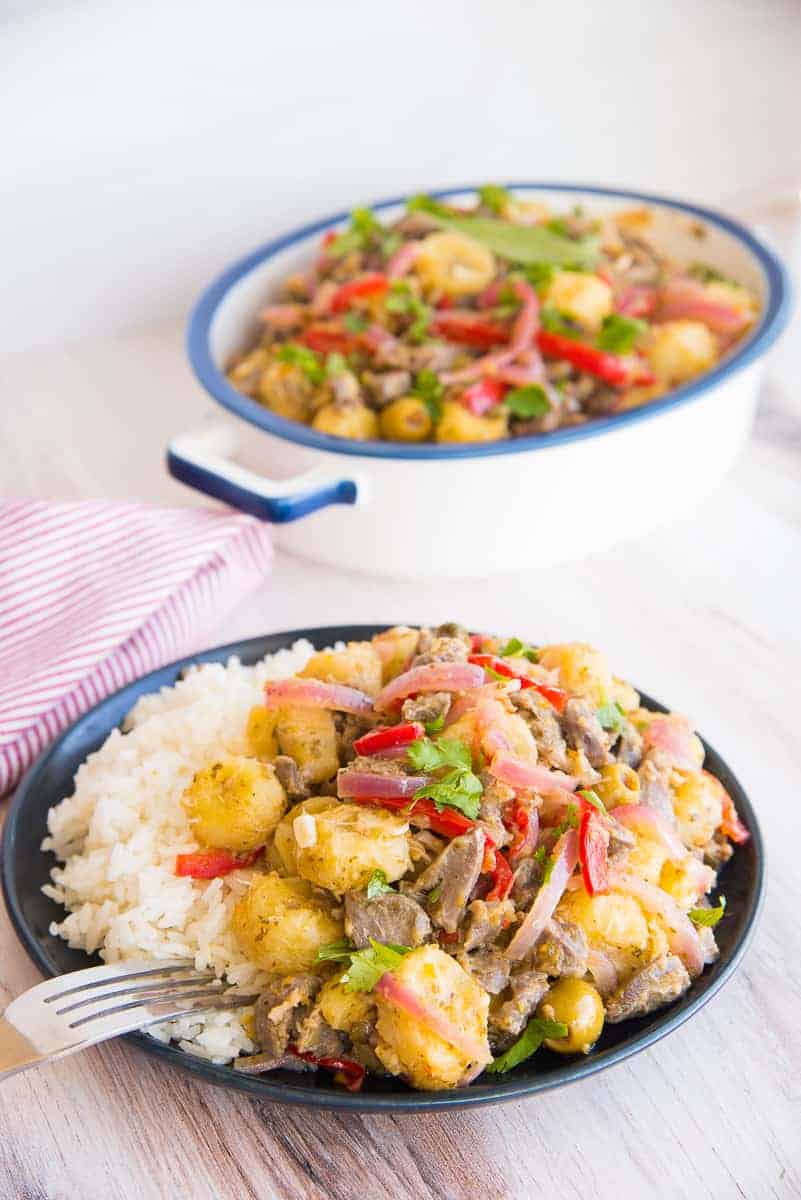
What Are Guineitos con Mollejas en Escabeche?
Guineitos con mollejas en escabeche is a Puerto Rican recipe made with tender chicken gizzards and green cooking bananas smothered in vinegar and oil sauce. I like to add a ton of aromatics to my recipe, but the main flavors are creamy (from the guineos), meaty (gizzards), and acidic (from the escabeche sauce).
Guineitos con mollejas en escabeche, pronounced ghee-nay-EE-toes cohn moh-YEH-hahs ehn ehs-cah-beh-CHAY, is, most often, a main course, but can also serve as a side dish or appetizer. Guineitos verdes is the diminutive form of guineo verde, which is what Puerto Ricans call a green cooking banana. Don’t confuse green cooking bananas with the yellow Cavendish bananas you add to your banana bread. Though they are the same variety, guineos, or green bananas, are unripe bananas and aren’t sweet at all. As a result, this boiled green banana dish is more of a savory dish.
Where Does the Dish Come From?
This particular recipe is a Puerto Rican escabeche. Other Caribbean countries, and many Latin American countries outside of the Caribbean, have their own versions of this dish. For many Puerto Ricans, guineitos con mollejas is most often served during the holidays, especially around Christmas and New Year’s Day.
Bananas arrived in the Americas, and later Puerto Rico, via the Columbian Exchange. Chickens most likely came to the islands in the same way. Much like the history of the U.S., the enslaved peoples created dishes like this using the parts of the animal that the upper-class Puerto Ricans (mainly descendants of the Spanish settlers) eschewed.
Throughout the years, guineitos con mollejas became one of the most loved Puerto Rican dishes, regardless of social class.
What do I need to make Guineitos con Mollejas en Escabeche?
Guineitos con mollejas en escabeche is made with guineos (green cooking bananas), mollejas (chicken gizzards), white wine vinegar, fresh lime juice, extra-virgin olive oil, sofrito, red bell pepper, purple (or red) onion, garlic, green olives, capers, allspice, black peppercorns, oregano, bay leaves, and salt.
Everything cooks in a caldero or large pot. Making guineitos con mollejas requires time because chicken gizzards are inherently tough. Like I always say, though, you’re worth it.
What are Mollejas?
Mollejas means sweetbreads in Spanish. Sweetbreads can be from the thymus of an animal that has one, like a cow or a sheep. But sweetbreads can also come from the pancreas of an animal, like a chicken.
Mollejas de pollo are chicken gizzards.
Chicken gizzards taste like chicken when fried. In this recipe, the escabeche marinade makes them tangy and garlicky and damn good.
Most people dislike gizzards because the ones they ate were improperly prepared. Mollejas that are not properly cleaned, trimmed, or tenderized are gritty, tough, and hard to chew. Hector found that out the hard way when he decided to fry them without tenderizing them first.
What Part of the Chicken Do Gizzards Come From?
A gizzard is an organ. More specifically, it is the muscular stomach of a chicken.
Chickens swallow little pebbles and sand to help break down their food since they don’t have teeth like we do. The gizzard breaks down the food to fuel the poultry using those stones and pebbles.
All poultry have a gizzard, so you can make this recipe with whichever bird you can get your hands on.
Gizzards are surrounded by a thick, yellowish membrane and covered with a thin layer of silver skin. Gizzards require a significant cooking time to tenderize them because of how much they are used in the animal. My recipe cuts down on that prep time considerably.
How Do I Prep the Gizzards For This Recipe?
You have to first trim your gizzards before cooking them until tender.
I go a bit farther than most when trimming my gizzards. Gizzards have a thick, wrinkled membrane surrounding them that feels rubbery and tough even after the gizzard is tender.
If you’re a fan of big textures, you can trim just the really hard middle membrane. The one that holds the two halves of the gizzard together.
Trim the middle membrane of the gizzards using a paring knife. Image 1 shows the underside of the molleja. That silverskin is one of the only things I would leave on the gizzard, but I had time that day, so I got rid of it. Here’s how to trim chicken gizzards:
- Flip the chicken gizzard so the wrinkly yellow side is facing up. Use your paring knife to cut between the thick, yellow membrane and the deep red organ.
- When you hit the cutting board, make a sharp right turn and slide the knife between the silver skin and the gizzard. The dark red nugget will pop out, leaving the silver skin and membrane behind. Trim away any excess, visible fat as well.
- Next, cut the gizzard into 1/2-inch pieces. Only cut the big ones in half. You can leave tiny gizzards uncut. Just cut the mollejas down into bite-sized pieces.
Can I Use Other Parts of the Chicken For This Recipe?
You can replace the gizzards in this mollejas en escabeche with dark meat chicken if don’t care for them or don’t have any on hand. This will transform the dish to an escabeche de pollo.
Just bake or sauté 1 1/2-pounds of diced boneless, skinless chicken thighs and proceed as instructed with the escabeche step. You don’t need to simmer chicken meat as you do gizzards. Just cook the meat to an internal temperature of 165°F (74°C).
How Long Do I Have to Cook the Mollejas?
Add the mollejas to an 8-quart caldero along with the first quantity of salt.
Pour the cold water over the gizzards. Make sure it’s covered at least 4 inches by the water. Bring this up to a boil over medium-high heat.
Decrease the cooking temperature to medium-low and cover the pot once the liquid begins to boil. Simmer the mollejas for 45 minutes. Larger pieces of mollejas have to simmer for about 2 hours to tenderize properly, which is why you should cut them down to bite-sized pieces.
The gizzards will create foam on the surface of the water as they simmer, which you can strain off later.
Cook the mollejas just until they have a small amount of chew, like calamari or steak. The gizzards will still have a bit of chew after 45 minutes of simmering, which is great because they will continue cooking for 12-15 minutes with the bananas.
Can I Cook the Mollejas In a Pressure Cooker?
You can cut the cooking time down on the mollejas by cooking them in an electric pressure cooker (or Instant Pot):
- Trim and rinse the gizzards and add them to your pressure cooker pot.
- Add one cup of water and 1 tablespoon of salt to the pot.
- Seal the pressure cooker according to the instructions
- Bring the pressure cooker up to “high pressure.” Set the time to cook for 25 minutes.
- Allow the pressure cooker to depressurize naturally for 15 minutes before draining and rinsing.
I’m not a huge fan of using the pressure cooker for this recipe because you’ll have to boil the guineos separately because they turn to mush if you cook them with the mollejas.
Where Do I Find Guineitos?
Guineitos is the diminutive form of guineos, or green cooking bananas, which translates to “little bananas.” Guineos en escabeche is often used when the bananas are left in larger pieces. Since we’re cutting the guineos into smaller pieces in this recipe, we’re calling them guineitos.
Look for guineos verde (or green bananas) at Hispanic, African, or Asian markets. You can also ask the produce manager at your local grocery store to order “ungassed bananas” for you.
Guineos verde aren’t the same as green plantains. You can replace the guineos in this recipe with sliced, then halved, peeled green plantains, however.
How Do I Prepare the Guineos For This Recipe?
Cut the stem ends of the guineos off, and make a slit with the tip of your knife down the back and front of the bananas. Soak the guineos verde in hot tap water for 10 minutes to soften the peels. Green bananas that are a little ripe may not need to soak.
Use the fleshy part of your thumb to push up and run your thumb down the length of the peel of the green banana.
Cut the guineos into 1/2-inch thick slices and put the slices into a bowl. Add 2 cups of cold water to the bowl or just enough to cover the bananas. Set the bowl aside for now if you’re still simmering the mollejas.
How Long Do I Boil the Green Bananas?
After the gizzards are done simmering (or until just tender to your bite), add the bananas, along with their water, to the pot with the mollejas.
Increase the temperature to medium-high and bring the liquid in the pot up to a boil. Once the water begins to boil, reduce the heat to medium-low and cover the pot. Simmer the contents for 12-15 minutes or until the guineos are fork-tender.
Pour the guineos con mollejas into a colander and rinse them with cool water once the guineitos are tender. Allow them to drain while you prepare the escabeche sauce.
How Do I Make the Escabeche Sauce?
Make the escabeche sauce in the pot you used for the mollejas and guineos. Just give it a quick rinse and wipe out any big pieces of gunk left in it.
Add the oil to the pot and heat it over medium-high heat. Once the oil begins to shimmer on the sides of the pot, add the purple (or red) onion. Next, add the kosher salt. Sauté the onions for 5 minutes, frequently stirring to keep them from sticking to the bottom of the pot.
Add the sofrito and the garlic to the pot and sauté these for 1-2 minutes or until the garlic looks glossy.
Add the white wine vinegar and lime juice to the pot. I grew up eating escabeche made with only white distilled vinegar. While it was good, it was also borderline harsh-tasting. I like the mellower flavors that the lime juice and white wine vinegar give this recipe.
Also, add the red bell pepper, oregano, bay leaves, olives, and capers, to the pot and bring this up to a rapid simmer.
Here’s How to Make Your Guineitos con Mollejas en Escabeche “Diner-friendly.”
Escabeche is a pickling sauce, so peppercorns are a must. I add more flavor by including allspice– or pimienta/pimento– along with the peppercorns.
I add the spices to a tea strainer to avoid having to dodge whole spices while eating it. Close the tea strainer, lay it in the center of the pot, and spoon some liquid over it. If you don’t have a tea strainer, you can do the same by putting the spices in a cheesecloth sachet. Tie the sachet tightly and add it to the pot. It’s also fine to just add the spices to the pot whole. Most of us have eaten it this way our whole lives and lived to tell the tale.
Cover the pot once the liquid comes to a simmer and reduce the temperature to low. Cook the escabeche for 10 minutes stirring once or twice.
How Do I Finish the Guineitos con Mollejas en Escabeche?
After 10 minutes, the acidic liquids and oil will have combined with the rest of the ingredients and mellowed out.
Return the guineitos y mollejas to the pot and use a spoon to gently fold them in. The starches from the guineitos mix with the liquid in the escabeche to create this amazing glaze on the guineitos and mollejas.
Cover the pot and turn the stove off. Leave the pot on the stove and allow the guineitos and mollejas to warm for 5-10 minutes before serving.
Can I Make This a Vegetarian Recipe?
To make vegan Guineos en Escabeche, omit the mollejas in this recipe and increase the number of guineos to 10.
Do I Serve Guineitos con Mollejas en Escabeche Hot or Cold?
Guineitos con mollejas are most commonly served at room temperature or cold. However, this is a matter of preference. You can serve them piping hot if you want to.
If you plan to serve them at room temperature, it’s best to only serve what you can eat in one sitting. Once your food falls within that food danger zone (40°F-140°F/4°C-60°C), you’re on borrowed time.
How Do I Serve Guineitos con Mollejas en Escabeche?
Serve guineitos con mollejas en escabeche as an entree with Steamed White Rice.
If you want to serve guineitos con mollejas as a side dish or appetizer, it needs no other accompaniments.
How Do I Store Leftovers?
To store leftover guineitos con mollejas en escabeche, transfer them to a food storage container and refrigerate them for up to 3 days.
You can eat them cold or warm them slightly (or completely) in the microwave when you’re ready to eat them.
Consume whatever you heat up that day, though. Don’t return them to the fridge after you’ve reheated them.
Can I Freeze Guineitos con Mollejas en Escabeche?
I’ve only frozen this dish once, and that was to see if it was possible.
I don’t recommend freezing guineitos con mollejas en escabeche since the consistency of the mollejas becomes hard to chew, and the escabeche doesn’t taste as flavorful.
If you must freeze them, allow the food to cool and transfer it to a freezer-safe container. Freeze the guineitos con mollejas for up to 2 months. Thaw them completely in the fridge, then enjoy or reheat them as recommended above.
What Other Recipes Are Commonly Served with Guineitos con Mollejas?
For a traditional Puerto Rican holiday dinner, serve Guineitos con Mollejas en Escabeche with other Puerto Rican recipes like Pernil (Puerto Rican Roast Pork Shoulder), Arroz con Gandules (Rice with Pigeon Peas), Pasteles (Meat-Filled Root Vegetable Patties), and Ensalada de Papa (Puerto Rican-Style Potato Salad).
Add a typical Puerto Rican holiday dessert like Arroz con Dulce, Mantecaditos, or Flan, and a couple of bottles of Coquito for a truly authentic end to your special occasion or holiday.
Try this Guineitos con Mollejas en Escabeche recipe out this year, and let me know what you think in the comments below. Don’t forget to share it far and wide, too!
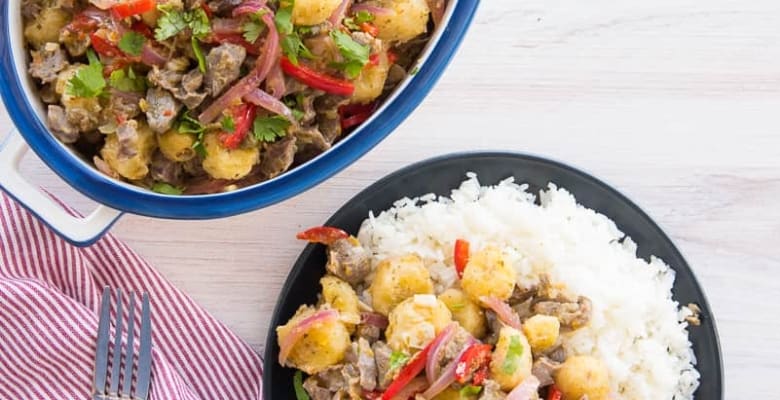
Guineitos con Mollejas en Escabeche (Marinated Green Bananas with Chicken Gizzards)
at Sense & EdibilityEquipment
- 8- or 10-quart dutch oven or caldero
Ingredients
For the Guineitos con Mollejas
- 1 1/2 pounds (680 grams) chicken gizzards trimmed (see post), cut into 1/2-inch pieces, and rinsed
- 1 tablespoon (15 grams) kosher salt
- 8 cups (2 liters) cold water for cooking the mollejas
- 6 green cooking bananas peeled and sliced covered with 2 cups (500 milliliters) of cold water
For the Escabeche Sauce
- 1 cup (250 milliliters) extra virgin olive oil
- 1 large (2 cups) red onion thinly sliced
- 1/2 tablespoon (8 grams) kosher salt plus more to taste
- 1/3 cup (89 grams) sofrito
- 5 cloves (1/4 cup) garlic thinly sliced
- 1/2 cup (125 milliliters) white wine vinegar
- 1/4 cup (63 milliliters) lime juice (from 2 medium limes)
- 1 small (1 cup) red bell pepper sliced
- 1/4 cup (45 grams) manzanilla olives
- 1 tablespoon (8 grams) capers
- 2 large bay leaves
- 1 teaspoon black peppercorns
- 1 teaspoon whole allspice berries
- 1 1/2 teaspoons dried oregano leaves
To Serve
- steamed white rice
- ripe avocado slices
Instructions
Simmer the Mollejas
- Add the trimmed chicken gizzards (mollejas) to a 8-quart caldero along with the salt. Pour the cold water over the gizzards. Make sure it's covered at least 4 inches by the water. Bring the water up to a boil over medium-high heat.
- Once the liquid comes to a boil, decrease the temperature to medium-low.Cover the pot and simmer the gizzards for 45 minutes*.
- After the gizzards have simmered for 45 minutes, or they're just tender to your preference, pour the bananas into the along with the water they were soaking in.Increase the temperature to medium-high and bring the liquid in the pot up to a boil. Once the water begins to boil, reduce the heat to medium-low and cover the pot. Simmer the bananas for 12-15 minutes, or until the guineos are fork-tender.
- Pour the guineos con mollejas into a colander and rinse them with cool water. Allow them to drain in place while you prepare the escabeche sauce.
Make the Escabeche Sauce
- Rinse out the pot and return it to the stove. Add the oil to the pot and begin heating it over medium-high heat.
- Once the oil begins to shimmer in the pot, add the onion. Sprinkle the kosher salt evenly over the onions. Use a wooden spoon to stir the salt and the onions to combine. Sauté the onions for 5 minutes, frequently stirring to keep them from sticking to the bottom of the pot.
- Next, add the sofrito and garlic to the pot. Sauté these for 1-2 minutes or until the garlic looks glossy, stirring frequently.
- Add the white wine vinegar and lime juice to the pot, along with the red bell pepper, olives, capers, bay leaves, peppercorns, allspice berries, and oregano to the pot. Stir to combine and bring this up to a rapid simmer.
- Cover the pot once the liquid comes to a simmer and reduce the temperature to low. Cook the escabeche for 10 minutes stirring once or twice.
Return the Guineitos and Mollejas To the Pot
- After 10 minutes, return the guineitos and mollejas to the pot and use a spoon to gently fold them into the escabeche sauce. Cover the pot and turn the stove off. Leave the pot on the stove and allow the guineitos and mollejas to warm through for 5-10 minutes before serving.
- Serve the guineitos con mollejas en escabeche as a main dish with steamed white rice and slices of ripe avocado. You can also serve it on its own as an appetizer.
Notes
Swaps and Substitutions:
- Green cooking bananas are not the same as yellow Cavendish bananas or plantains. Ask your produce manager for ungassed bananas.
- You can replace the guineos with 2 large green plantains that are peeled, cut in half, then sliced into 1/2-inch thick pieces.
- All poultry have a gizzard, so you can make this recipe with gizzards from any bird you'd like.
- To replace the gizzards for chicken:
- Skip the boiling step and, instead, bake or sauté 1 1/2-pounds (680 grams) of diced boneless, skinless chicken thighs, to an internal temperature of 165°F (74°C).
- Dice the meat and fold it into the escabeche sauce with the boiled guineos.
- Replace the white wine vinegar and/or the lime juice with white distilled vinegar. This will make the escabeche more harsh.
Tips and Tricks:
- If you leave your mollejas in bigger pieces, increase the simmering time. Larger pieces can take up to 2 hours to tenderize, which is why I recommend cutting the gizzards into bite-size pieces.
- Mollejas are ready to move forward in the recipe if they have just a small amount of chew to them like calamari or steak. If the gizzards still have a bit more chew that's okay because they will continue cooking for 12-15 minutes while you cook the bananas.
- If your guineos are really green, they may be hard to peel. To loosen the peel, soak them for 10 minutes in hot tap water after cutting off the ends and cutting a slit down the back and front of the banana.
- Add your whole peppercorns and allspice berries to a tea strainer or a cheesecloth satchet. Remove them just before stirring in the bananas and gizzards. This will make eating the guineitos con mollejas easier.
Pressure Cooker Method:
- Trim and rinse the gizzards as recommended.
- Add them to a pressure cooker pot with just one cup of water and 1 tablespoon of salt.
- Seal the pressure cooker according to the manufacturer's instructions, then bring the pressure cooker up to "high pressure." Set the time to cook for 25 minutes.
- Allow the pressure cooker to depressurize naturally for 15 minutes before draining and rinsing and proceeding with the recipe as instructed.
Storage and Reheating Instructions:
- Transfer leftover guineitos to a food storage container and refrigerate them for up to 3 days.
- Eat them cold or warm them slightly (or completely) in the microwave when you're ready to eat them.
- Consume whatever you reheat in the same day. Don't return reheated mollejas to the fridge.
Freezing Instructions (Not Recommended):
- Cool the guineitos and mollejas completely.
- Transfer them to a freezer-safe container.
- Freeze them for up to 2 months.
- Thaw them completely in the fridge when you're ready for them, then enjoy or reheat as recommended above.

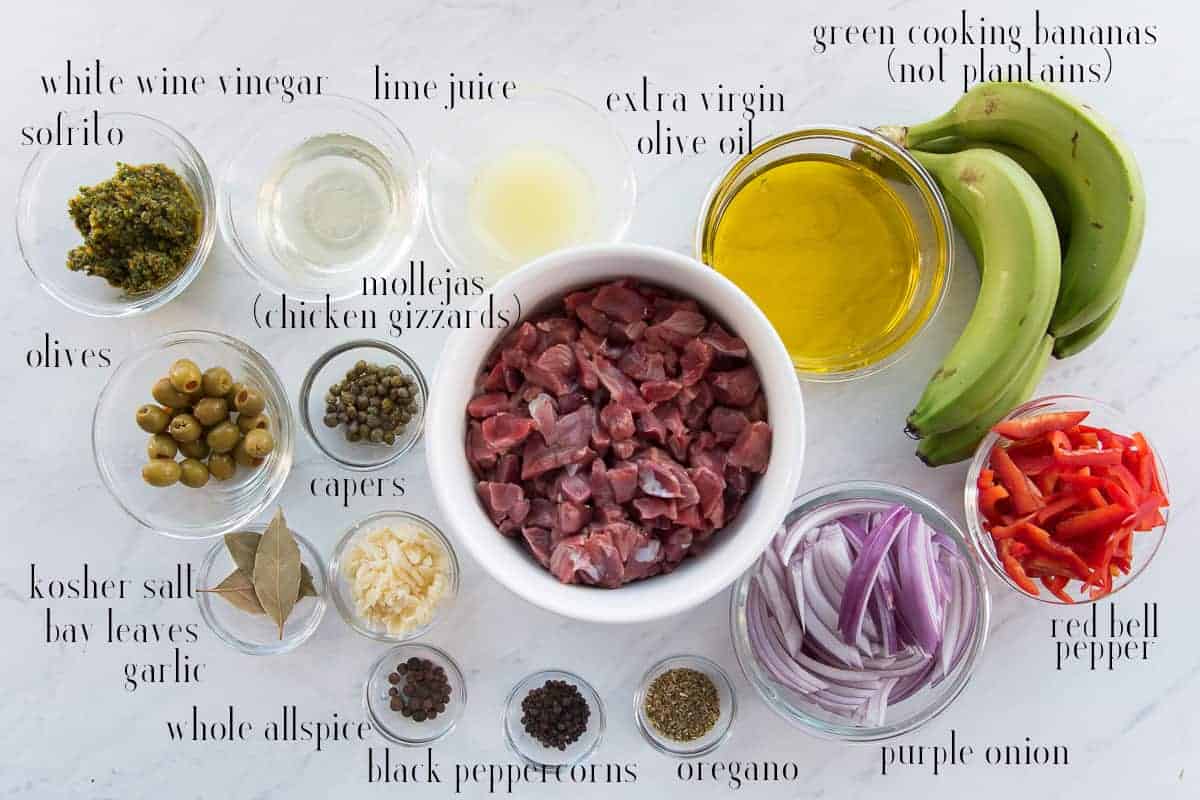
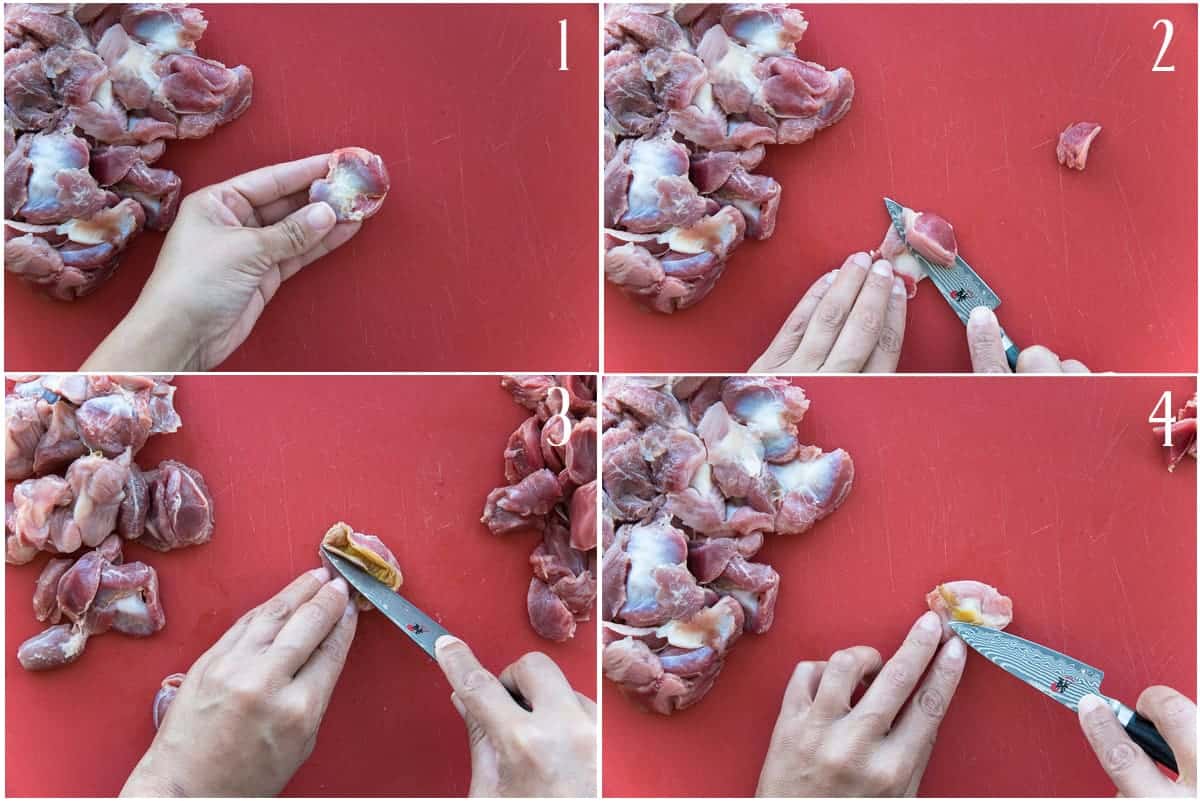
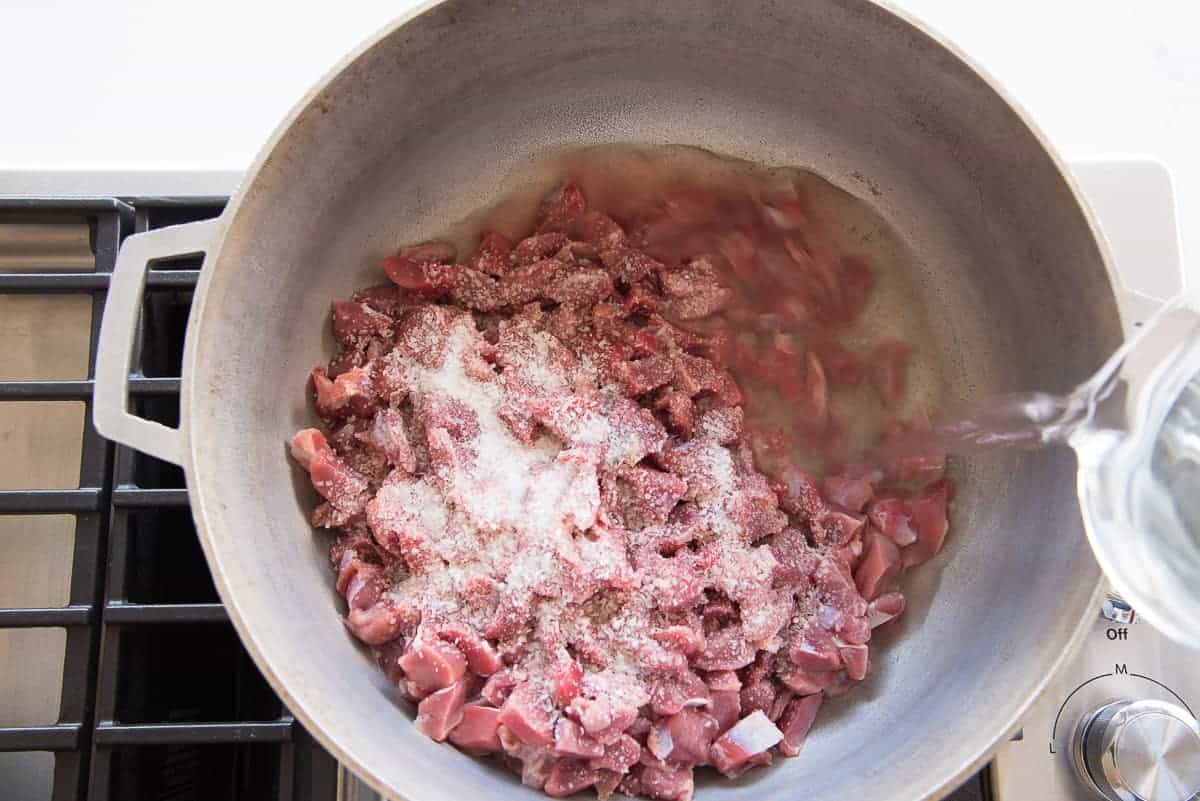
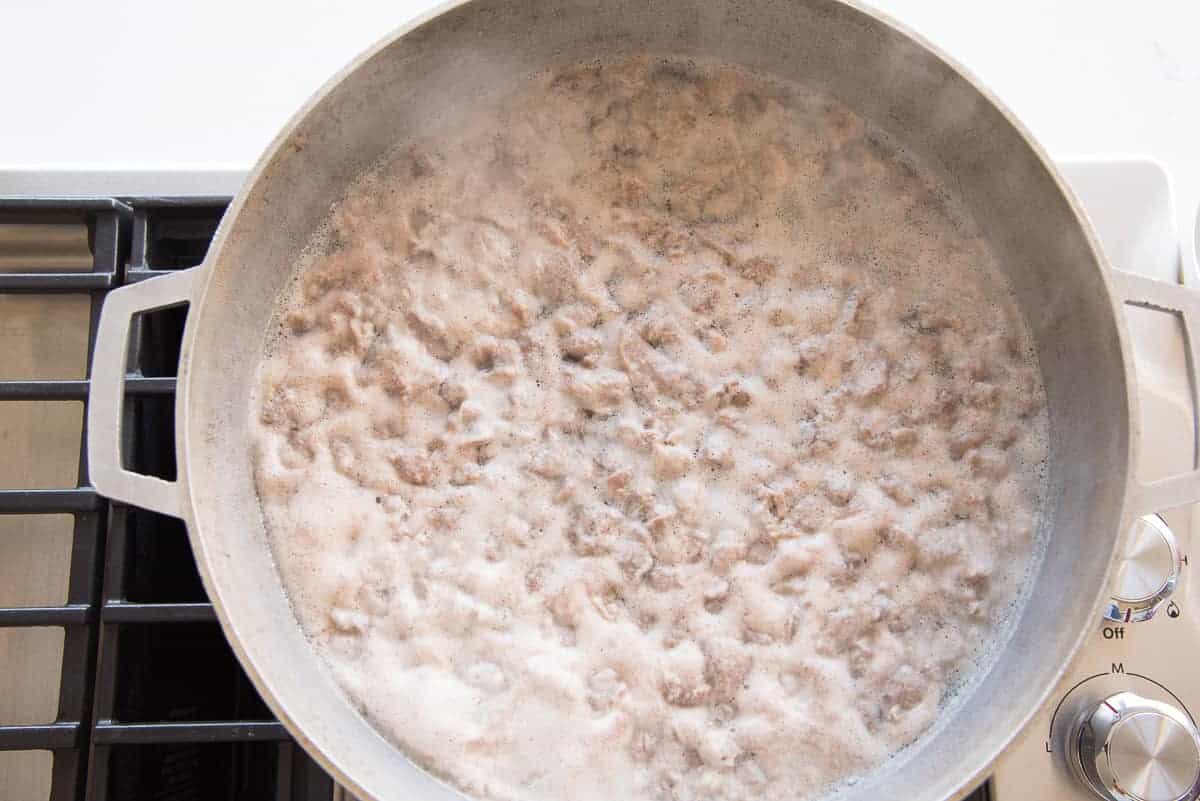
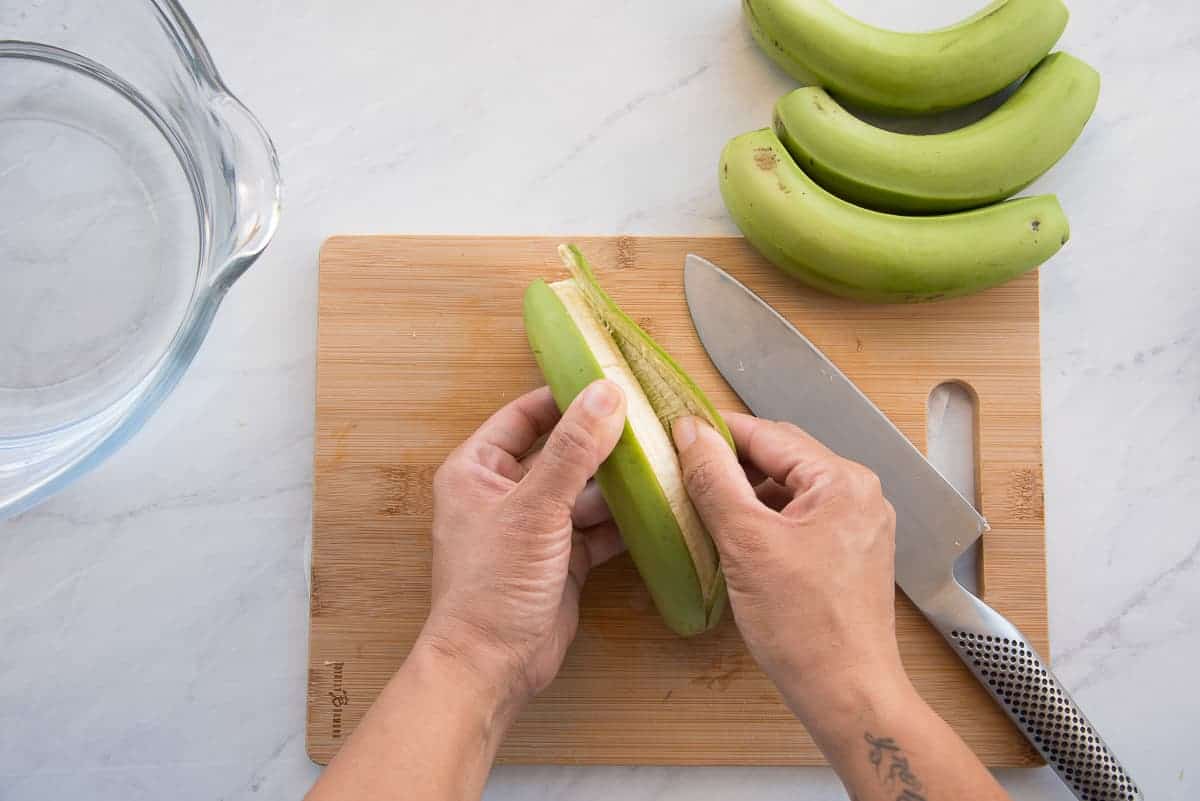
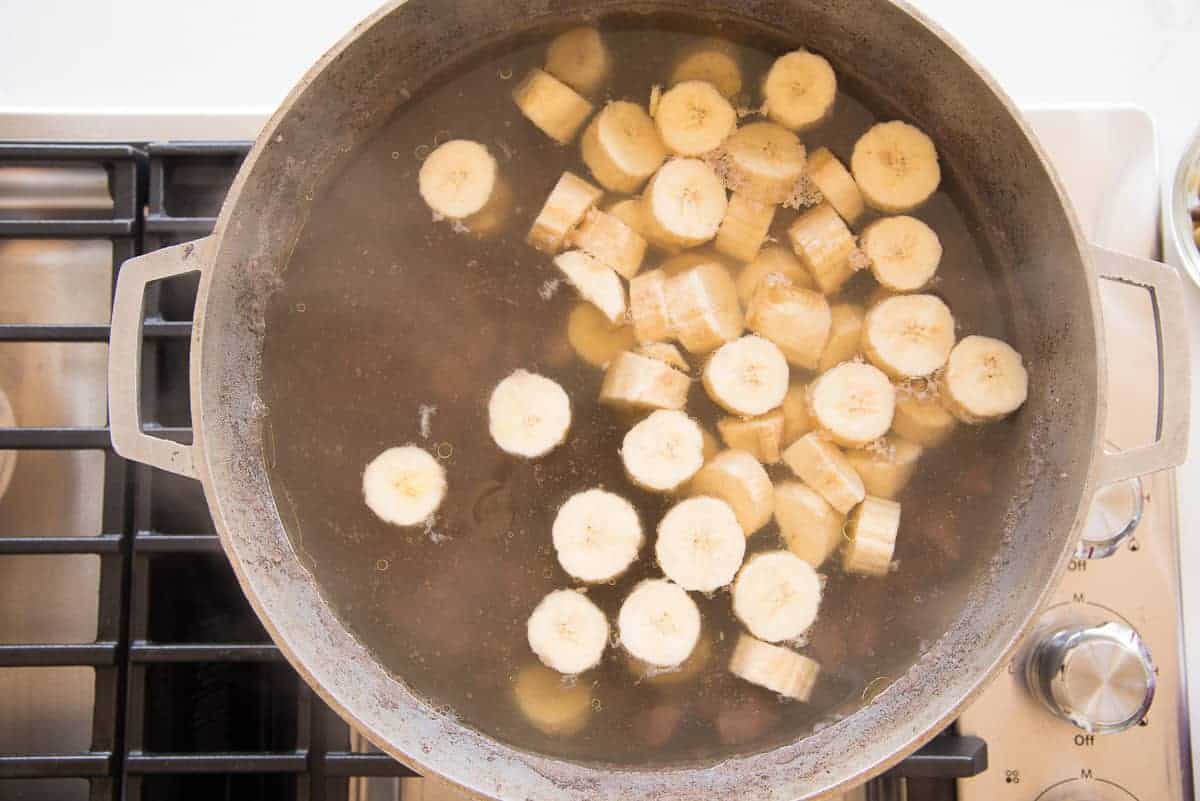
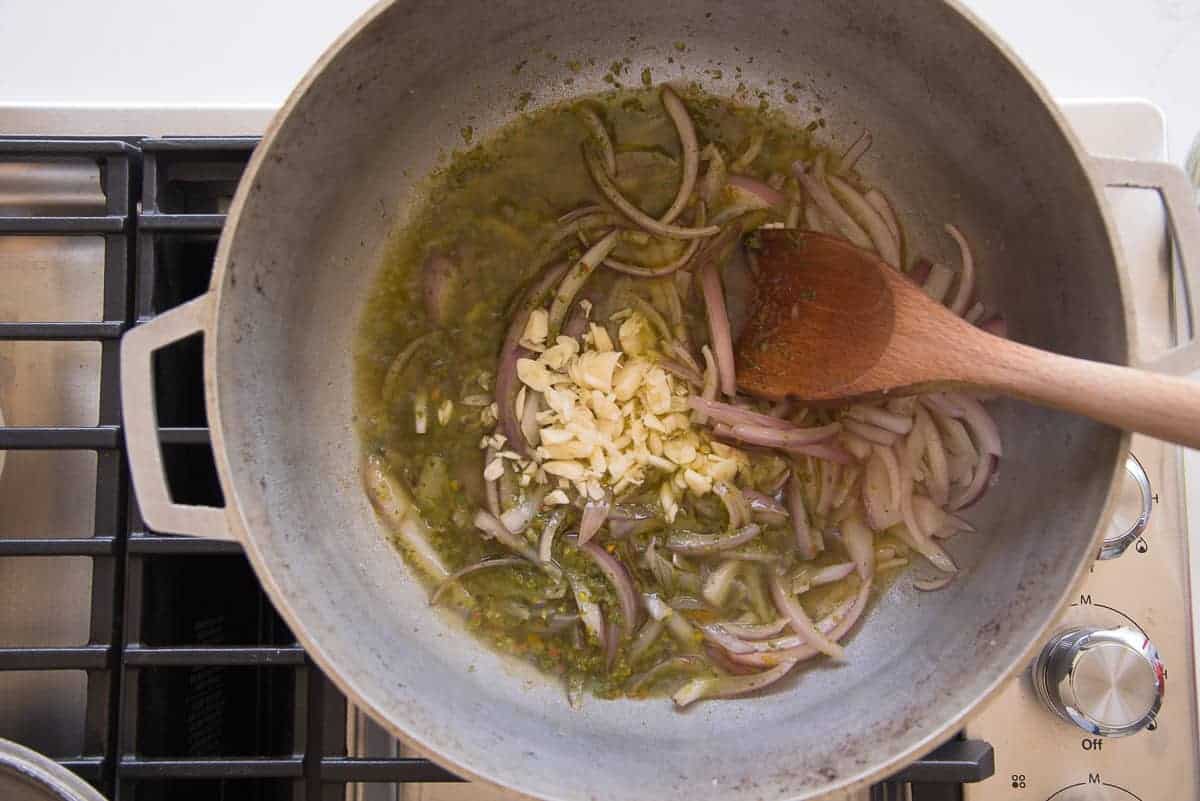
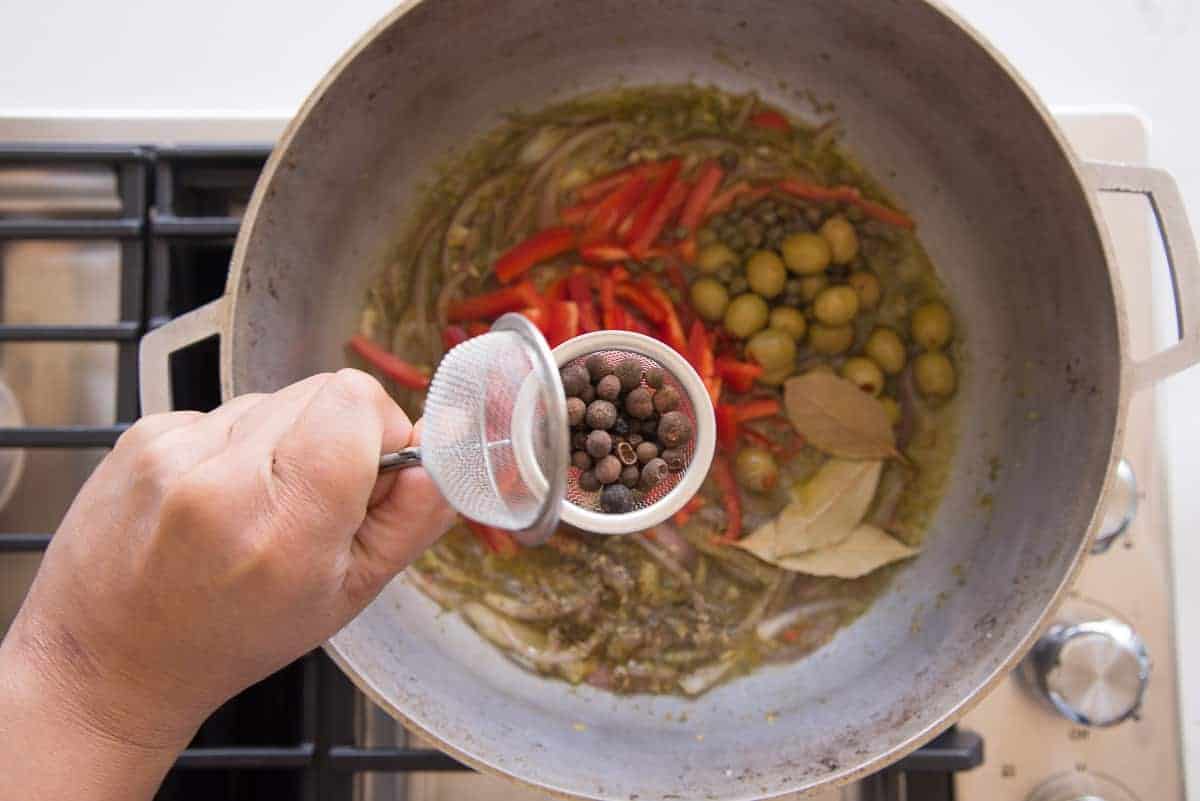
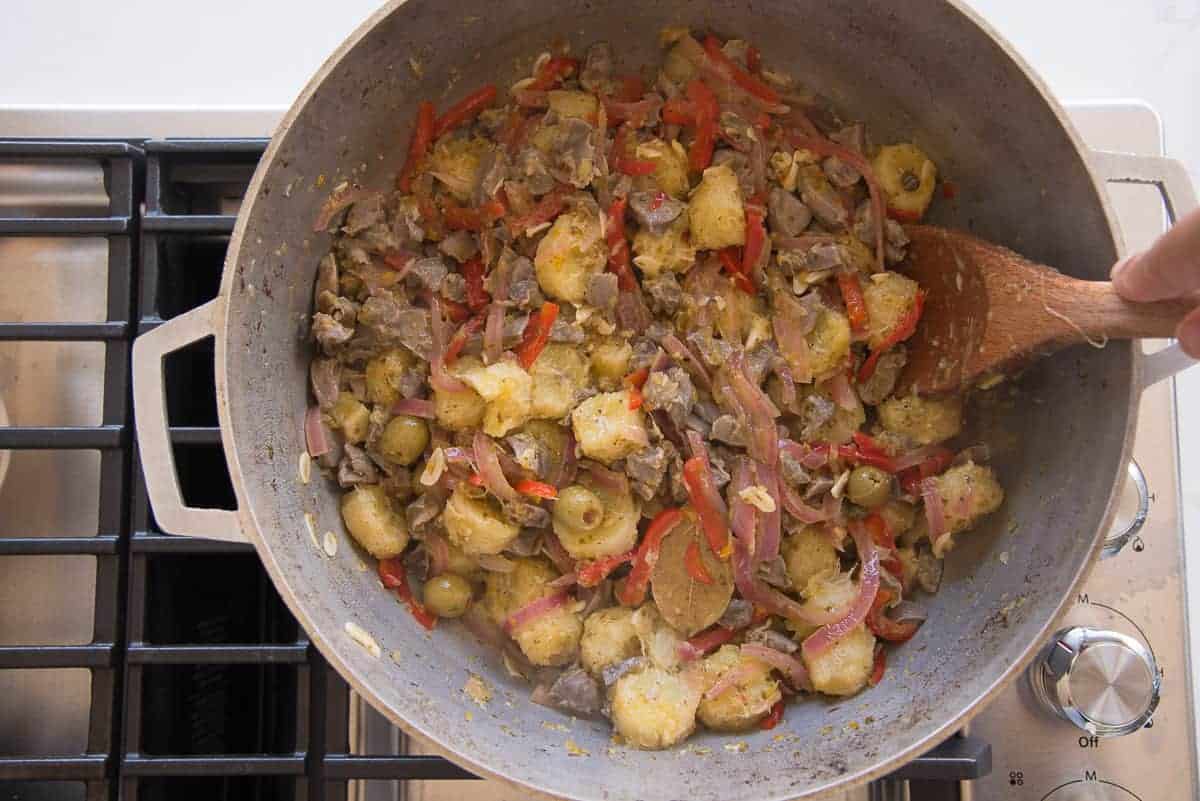
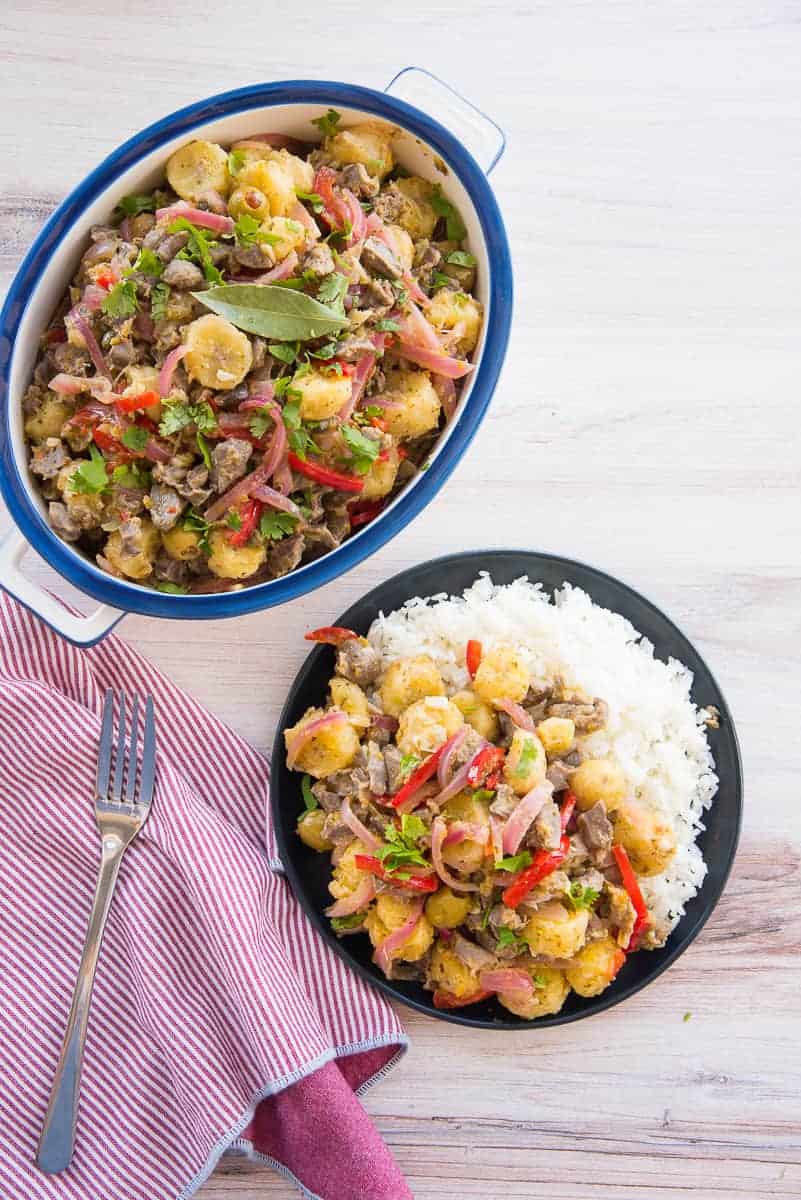
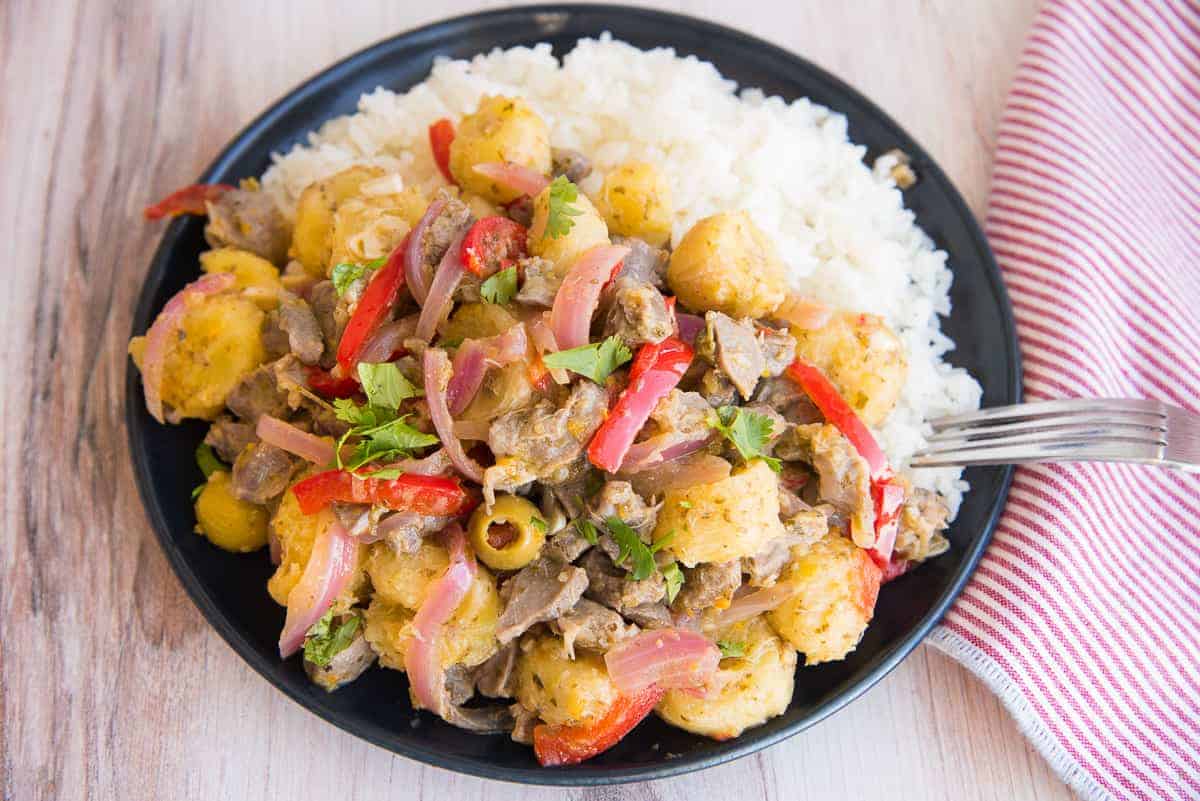
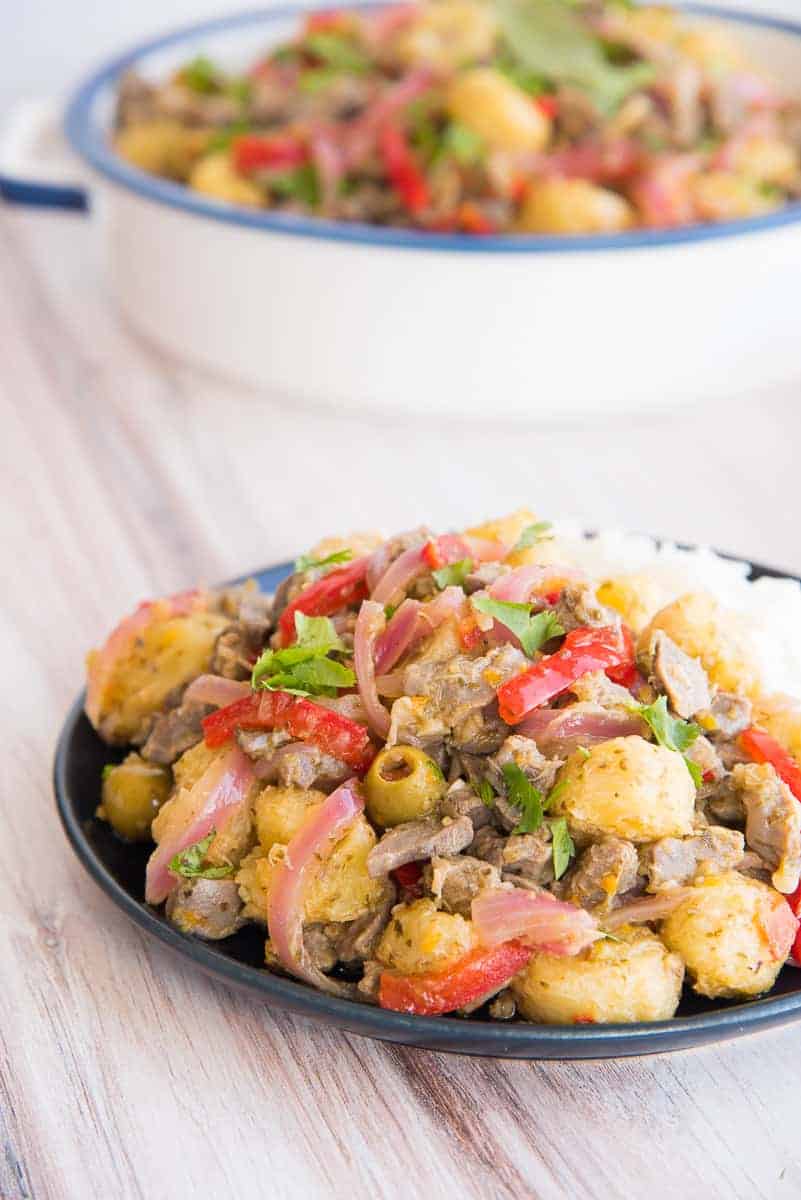
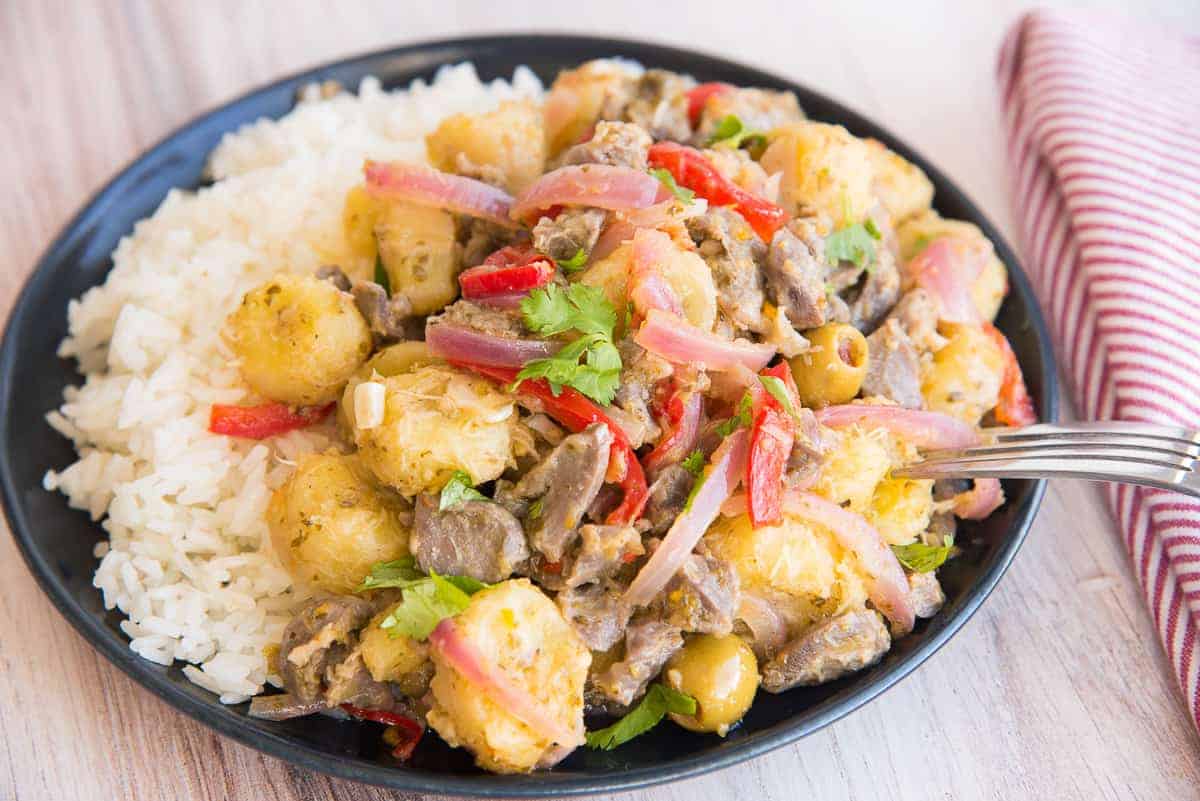
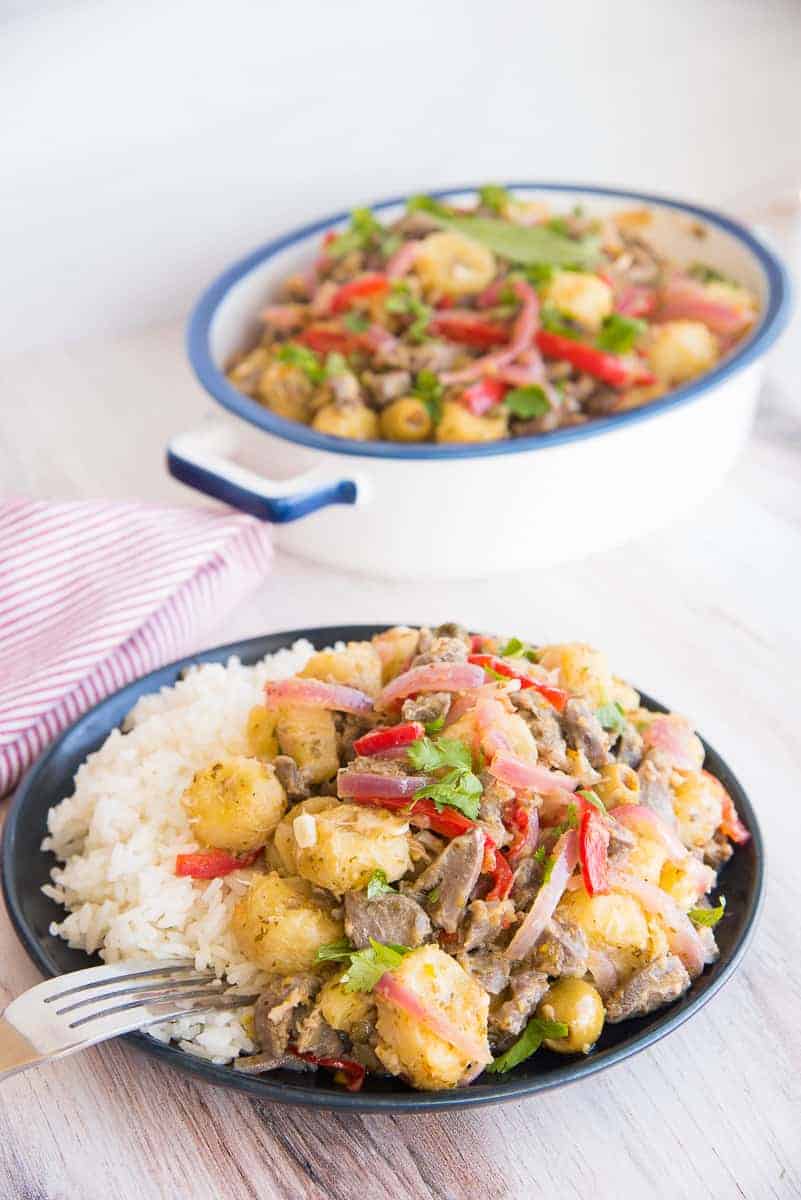



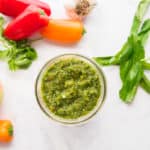

Ok at first I was a bit put off but to be honest the combination of flavours sounds amazing so I’m definitely willing to try
You have to try it, Mimi. It will change your life.
Sign me up! this looks so tasty!! I love comfort food when its cold.
Same here!!
While I am not a fan of Chicken Gizzards I love the story behind this holiday recipe.
Thanks!
omg this looks divine!! definitely going to try to recreate it!
Enjoy it!
hmmnnn gizzards? if it looks that good i bet it’s delicious!
Yep! Gizzards. Most people on the planet eat them.
Do you know I was 25 the first time I handled raw meat!? HA! So… yeah, I’m almost 40 now but gizzards… I wasn’t ready for that!! But my husband helped me and we finished it together. SO good!
Pretty sure you’ve handled worse things than gizzards, but I’m glad you liked it.